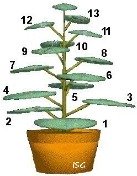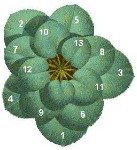New Solar Technology

Teenage inventor, Aiden Dwyer, created a new solar technology that emulates how trees convert sunlight into energy.
Following in the footsteps of inventors who use biomimicry (the science that derives models, systems or processes from nature), Aiden studied trees to perfect a solar technology that generates electricity, faster, and more efficiently than flat solar panels.
Related: Velcro, Honeycomb Tires, Nano-Tex Fabric
How It Works
Trees, shrubs and plants use an inherent structural design to expose their leaves to sunlight for photosynthesis.
How well they do this determines their survival, especially in forested areas that are densely populated with competing vegetation.
Aiden utilized the information on how plants are structurally designed to create his new solar technology.
This information originates from 1202, when the Italian mathematician Fibonacci published a book entitled "Liber Abaci" that introduced to Western mathematicians a numerical sequence that originated in India.
The numerical sequence is: 0, 1, 1, 2, 3, 5, 8, 13 and so on.
The first two numbers are 0 and 1, and each successive number is the sum of the previous two numbers.
Therefore, 0 + 1 is 1, 1 + 1 is 2, 1 + 2 is 3, 2 + 3 is 5, 3 + 5 is 8, 5 + 8 is 13 and so on.
 This sequence is known as the Fibonacci numbers.
This sequence is known as the Fibonacci numbers.
In botany, phyllotaxis is the structured pattern that leaves follow to arrange themselves on a plant.
In many species of plants and trees, this arrangement coincides with the Fibonacci number sequence.
For example, in this graphic of a plant, the leaves are numbered "1" to "13".
Using a string, if we begin at leaf "1" and rotated the string clockwise around the stem to each leaf until we arrive at a leaf that was directly above "1", we would have made 3 complete rotations and would have met 5 leaves.
 The Fionnaci numbers are 3, 5 or expressed as the ratio 3/5 beginning from the bottom leaf. In other words 3 clockwise rotations for 5 leaves.
The Fionnaci numbers are 3, 5 or expressed as the ratio 3/5 beginning from the bottom leaf. In other words 3 clockwise rotations for 5 leaves.
If we continue rotating our string upwards, we would make 5 rotations to meet 8 leaves to get to 13. The Fionnaci numbers are 5, 8, 13. This leaf arrangement creates the maximum exposure to sunlight.
Approximately 90 percent of plants are designed this way, however the patterns can begin at different ratios.
For example an elm tree begins at 1/2 (1 rotation for 2 branches), a beech is 1/3, an oak, cherry, or apple is 2/5, and a popular, pear or willow tree is 3/8.
New Solar Technology
Since the angle of the Sun's rays are not fixed, particularly during the changes in seasons, the use of fixed flat solar panels for homes is inefficient.
Some residential solar systems are designed to move and track the Sun but these systems substantially increase the cost of solar energy because they are expensive and require maintenance.
Using the 2/5 number pattern for the oak tree, Aiden designed a solar tree using an array of solar panels as leaves. He also made a flat solar panel with the same type and number of photovoltaic cells used in his solar tree.
This allowed him to compare the effectiveness of both solar power kits.
The solar tree design produced 20% more electricity than the flat solar panel.
It also captured 2.5 more hours of sunlight during the day, but when the Sun was on the horizon, the solar tree produced 50% more electricity and captured 50% more hours of sunlight than the flat solar panel.
Aiden's solar tree design won him the 2011 Young Naturalist Award from the American Museum of Natural History.
Aiden is currently perfecting his new solar technology by studying the Fionnaci number arrangements of various trees at different latitudes.
He has a patent pending for his invention, and we look forward to the possibility that our streets and yards will be landscaped with his new solar technology trees.
Related Articles: New Solar Technology, Solar Paint, Pop Can Panels, Cheap Solar Panels
Sources: amnh.org; maths.surrey.ac.uk; wikipedia.com



